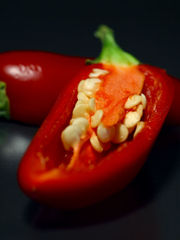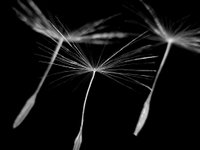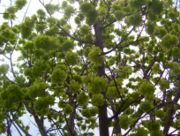Seed
2007 Schools Wikipedia Selection. Related subjects: General Biology; Plants
A seed is the ripened ovule of gymnosperm or angiosperm plants. The importance of the seed relative to more primitive forms of reproduction and dispersal is attested to by the success of these two groups of plants in dominating the landscape.
Seed structure
A seed contains the embryo from which a new plant will grow under proper conditions. Seeds also usually contain a supply of stored food and is wrapped in the seed coat or testa. Seeds are very diverse in size. The dust-like orchid seeds are the smallest with about one million seeds per gram. Orchid seeds have immature embryos and no significant food reserves. They are myco-heterotrophs, depending on mycorrhizal fungi for nutrition during germination. At over 20 kg, the largest seed is the coco de mer.
The embryo has one cotyledon or seed leaf in monocotyledons, two cotyledons in almost all dicotyledons and two or more in gymnosperms. The radicle is the embryonic root. The plumule is the embryonic shoot. The embryonic stem above the point of attachment of the cotyledon(s) is the epicotyl. The embryonic stem below the point of attachment is the hypocotyl.
In angiosperms, the stored food begins as a tissue called the endosperm, which is derived from the parent plant via double fertilization. The usually triploid endosperm is rich in oil or starch and protein. In gymnosperms, such as conifers, the food storage tissue is part of the female gametophyte, a haploid tissue.
In some species, the embryo is embedded in the endosperm or female gametophyte, which the seedling will use upon germination. In others, the endosperm is absorbed by the embryo as the latter grows within the developing seed, and the cotyledons of the embryo become filled with this stored food. At maturity, seeds of these species have no endosperm and are termed exalbuminous seeds. Some exalbuminous seeds are bean, pea, oak, walnut, squash, sunflower, and radish. Seeds with an endosperm at maturity are termed albuminous seeds. Most monocots (e.g. grasses and palms) and many dicots (e.g. brazil nut and castor bean) have albuminous seeds. All gymnosperm seeds are albuminous.
The seed coat develops from the tissue, the integument, originally surrounding the ovule. The seed coat in the mature seed can be a paper-thin layer (e.g. peanut) or something more substantial (e.g. thick and hard in honey locust and coconut). The seed coat helps protect the embryo from mechanical injury and from drying out.
The seeds of angiosperms are contained in a hard or fleshy (or with layers of both) structure called a fruit. Gymnosperm seeds begin their development "naked" on the bracts of cones, although the seeds do become covered by the cone scales as they develop. An example of a hard fruit layer surrounding the actual seed is that of the so-called stone fruits (such as the peach).
Some seeds have an appendage on the seed coat such an aril (as in yew and nutmeg) or an elaiosome (as in Corydalis) or hairs (as in cotton). The hilum is the scar on the seed coat where the seed was attached to the ovary wall by the funiculus.
In order for the seed coat to split, the embryo must imbibe (soak up water), which causes it to swell, splitting the seed coat. However, the nature of the seed coat determines how rapidly water can penetrate and subsequently initiate germination. For seeds with a very thick coat, scarification of the seed coat may be necessary before water can reach the embryo. Examples of scarification include: gnawing by animals, freezing and thawing, battering on rocks in a stream bed, or passing through an animal's digestive tract. In the latter case, the seed coat protects the seed from digestion, while perhaps weakening the seed coat such that the embryo is ready to sprout when it gets deposited (along with a bit of fertilizer) far from the parent plant. In species with thin seed coats, light may be able to penetrate into the dormant embryo. The presence of light or the absence of light may trigger the germination process, inhibiting germination in some seeds buried too deeply or in others not buried in the soil. Abscisic acid is usually the growth inhibitor in seeds.
Seed functions
Seeds protect and nourish the embryo or baby plant. Seeds usually give a seedling a faster start than a sporling from a spore gets because of the larger food reserves in the seed.
Unlike animals, plants are limited in their ability to seek out favorable conditions for life and growth. As a consequence, plants have evolved many ways to disperse their population through their seeds (see also vegetative reproduction). A seed must somehow "arrive" at a location and be there at a time favorable for germination and growth. Seed dispersal is often attributed mainly to fruits, however many seeds aid in their own dispersal, for example:
- Many seeds (e.g. maple, pine) have a wing that aids in wind dispersal.
- The dustlike seeds of orchids are carried efficiently by the wind.
- Some seeds, (e.g. dandelion, milkweed, poplar) have hairs that aid in wind dispersal.
- Seeds with a fleshy covering (e.g. apple, cherry, juniper) which is eaten by animals (birds, mammals) which then disperse the seeds in their droppings.
- Seeds ( nuts) which are an attractive long-term storable food resource for animals (e.g. acorns, hazelnut, walnut); the seeds are stored some distance from the parent plant, and some escape being eaten if the animal stores more than it needs, forgets where it has stored the seed, or dies.
- Seeds ( burrs) with barbs or hooks (e.g. acaena, burdock, dock) which attach to animal fur or feathers, and then drop off later.
- Seeds of some mangroves are viviparous, they begin to germinate while still attached to the parent. The large, heavy root allows the seed to penetrate into the ground when it falls.
- Some seeds have appendages called elaiosomes, e.g. bloodroot, trilliums and Acacias. Elaiosomes provide food for ants, which usually disperse such seeds.
- Some plants, such as Mucuna and Dioclea, produce buoyant seeds termed sea-beans or drift seeds because they float in rivers to the oceans and wash up on beaches .
For annuals, seeds are a way for the species to survive dry or cold seasons. Ephemeral plants are usually annuals that can go from seed to seed in as few as six weeks.
One important function of most seeds is delaying germination to allow time for dispersal and to prevent all seeds from germinating at once when conditions are favorable. Staggering germination prevents all seeds from germinating at once and being wiped out by bad weather or herbivores. Seed dormancy is defined as a seed failing to germinate under environmental conditions optimal for germination. It is often confused with seed quiescence, which is a seed failing to germinate because environmental conditions are inappropriate for germination. Many cultivated seeds lack dormancy but do not germinate in seed packets simply because there is insufficient moisture.
Origin and evolution
The origin of seed plants is a problem that still remains unsolved. However, more and more data tends to place this origin in the middle Devonian. The description in 2004 of the proto-seed Runcaria heinzelinii in the Givetian of Belgium is an indication of that ancient origin of seed-plants.
The first "true" seeds are described from the upper Devonian, which is probably the theatre of their true first evolutionary radiation. The seed plants progressively became one of the major elements of nearly all ecosystems.
Economic importance
Many seeds are edible. The majority of human calories comes from seeds, especially from cereals, legumes and nuts. Seeds also provide most cooking oils, many beverages and spices and some important food additives.
Seeds are used to propagate many crops such as cereals, legumes, forest trees, turfgrasses and pasture grasses.
Some seeds are also poisonous. One of the deadliest poisons, ricin, comes from seeds of the castor bean. Another seed poison is strychnine. Other poisonous seeds are those of yew, wisteria, apple, horse-chestnut and peach.
The world's most important clothing fibre grows attached to cotton seed. Other seed fibers are from kapok and milkweed.
Many important nonfood oils are extracted from seeds. Linseed oil is used in paints. Oil from jojoba and crambe are similar to whale oil.
Seeds are the source of some medicines including castor oil, tea tree oil and the discredited cancer drug, Laetrile.
Many seeds have been used as beads in necklaces and rosaries including Job's tears, Chinaberry and rosary pea. However, the latter two are also poisonous.
Other seed uses include:
- Seeds once used as weights for balances.
- Seeds used as toys by children, such as for the game conker.
- Resin from Clusia rosea seeds used to caulk boats.
- Nematicide from milkweed seeds.
- Cottonseed meal used as animal feed and fertilizer.
- Many seeds used as birdseed.
Oldest viable seeds
- The oldest carbon-14-dated seed that has grown into a viable plant was a Judean date palm seed about 2,000 years old, recovered from excavations at Herod the Great's palace on Masada in Israel. It was germinated in 2005.
- If the 2,000 year old Judean date palm seed longevity claim is confirmed by a report in a refereed scientific journal, then the second oldest viable seed would be the carbon-14-dated 1,300-year-old sacred lotus ( Nelumbo nucifera), recovered from a dry lakebed in northeastern China.
- There is a persistent myth that seeds from Egyptian tombs with ages of over 3,000 years were viable . The myth was reportedly started by scam artists selling "miracle seed" designed to capitalise on European Egyptomania of the 1800s. In 1897, the claims were tested by the British Museum's director of Egyptian antiquities, E. A. Wallis Budge. Budge provided genuine 3,000-year-old tomb-seeds to the Royal Botanic Gardens, Kew to plant under controlled conditions. The test resulted in no germination.
Seed packets and seed information
Generally, seed packets labels includes:
- Common plant name and the botanical name (in parentheses).
- Space and deep: how deep to place the seeds in the soil, space between plants (from one row to the other one and from one plant to the other one in the same row).
- Height: approximate height the plant will reach when mature.
- Soil: type of soil the plant prefers.
- Water: It can indicate "keep the soil lightly damp", "bottom water the plant", " drench the soil with water", "daily misting of water" and "almost dry out before re-watering".
- Sun: full direct sunlight, partial sun, diffused sunlight, or grows well in the shade.
- Door: if the plant is best suited for growing Indoor, Outdoor or Both.
- Live: Perennial or annual.
- Planting, germination and harvest period: a lot of plant germinates in March. This information can be indicated by months or quarters of the year.
- Special requirements, if necessary.
This information can be represented graphically.


